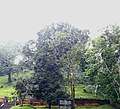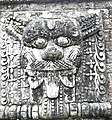Deopahar
The Deopahar (Assamese: দেওপাহাৰ, meaning " The Hill of the God") Archaeological Site is situated in Numaligarh, Golaghat district, Assam, India. It is a protected archaeological park and has a site-museum under the Directorate of Archaeology.[1]. On top of the hillock, there is an ancient stone temple whose construction is either incomplete or was damaged during the Assam earthquake of 1897.
| Deopahar Archeological Site | |
|---|---|
| Religion | |
| Affiliation | Hinduism |
| District | Golaghat |
| Location | |
| Location | Numaligarh |
| State | Assam |
| Country | India |
| Geographic coordinates | 26°36′08″N 93°43′52″E |
| Architecture | |
| Date established | 10th-11th century |
| Materials | Stone |

Location
The Deopahar hillock, also called Deoparvat, is by the side of the Asean Highway 1(NH39) in Numaligarh, Golaghat district, Assam, India. The Deopahar hillock is a part of the Deopani reserve forest. The Deopani reserve forest covers a total area of 133.45 hectares and is very rich in flora and fauna. The Deopani reserve forest area is an Elephant corridor and is also famous for a False Hemp Tree (Assamese : Bheleu)(Tetrameles nudiflora), which has been accorded a Heritage tree status, in the Deopahar hillock. Every year around the months of October to January, migratory wild giant bees follow the same migratory routes from the foothills of Himalaya to come to this particular tree to build several very big beehives. The Deopahar Archaeological Site is a tourist destination in Assam.[2] The distance of the Deopahar archaeological site is about 5 km from the Numaligarh Refinery, 61.8 km from Kaziranga National Park, 255 km from Guwahati and approximately 5 km by aerial distance from Brahmaputra River
History
The intricate architectural style of the Deopahar stone temple is indicative of the fact that it belongs to the period somewhere between 10th and 11th century AD. [3] The Deopahar temple was may be a temple of Lord Shiva. Legends says that the Shiva Linga from the Temple was shifted and the Baba Than, Numaligarh temple was established in the 19th century near the Deopahar hillock.[4]
Architecture
The stone temple was erected on a monolithic floor. The temple has a big ceiling slab engraved with a large lotus bearing a relief of Vidyadhara holding a scarf and a necklace by both hands. The vast range of sculptured stone blocks were curved out of Precambrian rocks. The stone blocks in the base of the temple were stabilised together with iron hinges which can be clearly seen.[5]
The overall creative style and design of the building blocks strongly reflects influences of the later Gupta era. There are huge door jambs with foliage of drooping petals, encircling creepers with animal and sculptural representations of female door keepers with coronets and huge perforated Patrakundalas. Other sculptural representation found are of Kirtimukha, Kalamakaras, Fangananm Shiva, Sridhar Rudra, Lakshi- Narayana, Hara Gauris Rashlila, Sarpadevata, Pranayam dhyan, Padma Sakra, Ram and Ravana, Sugriba etc. and panels with curvings of figures depicting episodes from the Ramayana, the Mahabharata and the Bhagavata Purana.
Photo gallery
 Temple Base - Deopahar
Temple Base - Deopahar Deopahar Archaeological Site View from Asean Highway 1- (NH 39)
Deopahar Archaeological Site View from Asean Highway 1- (NH 39) Deopahar -Kirtimukha
Deopahar -Kirtimukha Deopahar - Stone Statue
Deopahar - Stone Statue Deopahar - Stone Design
Deopahar - Stone Design Deopahar - Stone Statue
Deopahar - Stone Statue Deopahar - Iron hinges joining Stone blocks
Deopahar - Iron hinges joining Stone blocks
References
- "Home | Directorate of Archaeology | Government Of Assam, India". archaeology.assam.gov.in.
- "Historical Monuments | Assam Tourism Development Corporation Ltd | Government Of Assam, India". tourismcorporation.assam.gov.in.
- http://ignca.gov.in/asi_reports/ASSGHT_003.pdf Dated between 10th-11th century.
- "Welcome to Bokakhat Sub_division". www.bokakhat.gov.in.
- "Temple ruins on Dhansiri bank". www.telegraphindia.com.
- "Plea to make Deopahar a reserve forest". The Telegraph. Retrieved 2018-06-15.